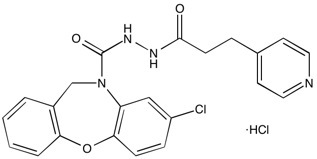SC-51089 | Prostaglandin E2 (EP1) antagonist
NMR (Conforms)

Available Options
| size : | Price | Quantity | |
|---|---|---|---|
| 5 mg | $55.00 | ||
| 25 mg | $220.00 |
SC-51089 (146033-02-5) is a prostaglandin E2 (EP1 receptor) antagonist (pA2=6.5, guinea pig ileum muscle strip assay )1,4. Possesses analgesic activity in vivo (rodent ED50= 6.8 mg/kg)1,2,4. SC-51089 does not inhibit COX11 and does not block PGE1 induced hyperalgesia3.
References/Citations:
1) Hallinan et al. (1993), N-substituted dibenzoxazepines as analgesic PGE2 antagonists; J. Med. Chem., 36
2) Malmberg et al. (1994), Antinociceptive effect of spinally delivered prostaglandin E receptor antagonists in the formalin test on rat; Neurosci. Lett., 173 193
3) Khasar et al. (1994), Comparison of prostaglandin E1- and prostaglandin E2 hyperalgesia in the rat; Neuroscience, 62 345
4) Hallinan et al. (1996), Aminoacetyl moiety as a potential surrogate for diacylhydrazine group of SC-51089, a potent PGE2 antagonist, and its analogs; J. Med. Chem., 39 609
NMR (Conforms)
Safety Data Sheet:
Product Data Sheet:
Materials provided by Focus Biomolecules are for laboratory research use only and are not intended for human or veterinary applications. Please note that we do not sell to individuals and that all orders placed by non-research organizations will incur a $20 restocking/refund fee
SC-51089 (146033-02-5) is a prostaglandin E2 (EP1 receptor) antagonist (pA2=6.5, guinea pig ileum muscle strip assay )1,4. Possesses analgesic activity in vivo (rodent ED50= 6.8 mg/kg)1,2,4. SC-51089 does not inhibit COX11 and does not block PGE1 induced hyperalgesia3.
References/Citations:
1) Hallinan et al. (1993), N-substituted dibenzoxazepines as analgesic PGE2 antagonists; J. Med. Chem., 36
2) Malmberg et al. (1994), Antinociceptive effect of spinally delivered prostaglandin E receptor antagonists in the formalin test on rat; Neurosci. Lett., 173 193
3) Khasar et al. (1994), Comparison of prostaglandin E1- and prostaglandin E2 hyperalgesia in the rat; Neuroscience, 62 345
4) Hallinan et al. (1996), Aminoacetyl moiety as a potential surrogate for diacylhydrazine group of SC-51089, a potent PGE2 antagonist, and its analogs; J. Med. Chem., 39 609
Related Pain and Inflammation Products
Download
Calculate the molar concentration, mass or volume in a solution.
Concentration × Volume × Molecular Weight = Mass
Focus Biomolecules • Plymouth Meeting, PA USA • 1-855-FOCUS21
Focus Biomolecules
Plymouth Meeting, PA USA
1-855-FOCUS21
Website Created by Advanta Advertising LLC.

